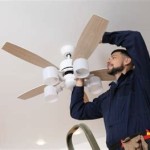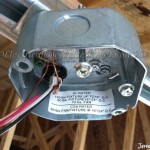Here's an article focusing on the critical considerations for selecting the appropriate ceiling fan size for a room: ```html
What Size Ceiling Fan For Room? A Comprehensive Guide
Selecting the correct size ceiling fan for a room is crucial for optimal airflow, energy efficiency, and overall comfort. A fan that is too small will struggle to circulate air effectively, leaving areas of the room stagnant and uncomfortable. Conversely, an oversized fan can create excessive drafts, consume unnecessary energy, and potentially overwhelm the space aesthetically. Determining the appropriate fan size requires careful consideration of the room's dimensions, particularly its square footage, as well as its ceiling height. This article provides a detailed guide to navigating the process of selecting the ideal ceiling fan size for a given room.
The primary factor determining the correct ceiling fan size is the room's square footage. Ceiling fan sizes are typically measured by the blade span, which is the diameter of the circle created by the rotating blades. This measurement directly correlates to the area the fan can effectively cool. While there isn't a single, universally accepted formula, general guidelines exist that provide a solid starting point. These guidelines typically categorize room sizes into small, medium, large, and extra-large, each corresponding to a recommended blade span range.
Determining Fan Size Based on Room Square Footage
The most fundamental method for determining the appropriate ceiling fan size is based on the room's square footage. Square footage is calculated by multiplying the length of the room by its width. Once the square footage is known, the following guidelines can be used:
Rooms up to 75 square feet: For very small rooms, such as walk-in closets, small bathrooms, or entryways, a ceiling fan with a blade span of 36 inches or less is typically sufficient. These smaller fans are designed to move air in compact spaces without creating overwhelming drafts.
Rooms between 76 and 150 square feet: Bedrooms, small offices, or dining areas often fall into this size category. A ceiling fan with a blade span between 42 and 48 inches is generally recommended for these spaces. This size provides adequate airflow without being too imposing on the room's design.
Rooms between 151 and 300 square feet: Living rooms, large bedrooms, and open-concept kitchens often require larger fans. A ceiling fan with a blade span between 50 and 54 inches is typically appropriate for these areas. This size ensures effective air circulation throughout the larger space, contributing to a more comfortable environment.
Rooms larger than 300 square feet: Great rooms, large living spaces, and master bedrooms exceeding 300 square feet may require even larger fans or multiple ceiling fans. A ceiling fan with a blade span of 56 inches or greater is often necessary for these rooms to provide adequate airflow. In very large rooms, consider using two or more smaller fans strategically placed to maximize air circulation.
These are general guidelines, and the optimal size might vary slightly depending on other factors such as ceiling height, room layout, and personal preference.
The Influence of Ceiling Height and Downrods
While square footage is the primary consideration, ceiling height plays a significant role in determining the appropriate ceiling fan installation and, consequently, the fan's effectiveness. The distance between the fan blades and the floor is critical for optimal performance and safety. Building codes and manufacturer recommendations generally specify a minimum clearance height between the floor and the fan blades, typically around 7 feet. If a room has a standard 8-foot ceiling, a flush-mount or hugger-style ceiling fan might be the best option to ensure adequate clearance.
For rooms with higher ceilings, a downrod is often necessary. A downrod is a metal pipe that extends the fan downward from the ceiling, positioning the blades at the optimal height for air circulation. The appropriate downrod length depends on the ceiling height. As a general rule, the following guidelines can be used:
8-foot ceilings: Flush-mount or hugger-style fans are recommended.
9-foot ceilings: A 6-inch downrod is typically sufficient.
10-foot ceilings: A 12-inch downrod is generally recommended.
11-foot ceilings: An 18-inch downrod is often appropriate.
12-foot ceilings or higher: A 24-inch or longer downrod may be necessary. Consider consulting a professional installer for guidance on selecting the correct downrod length for ceilings exceeding 12 feet.
Using the correct downrod length ensures that the fan blades are positioned at the optimal height to circulate air effectively without creating unsafe conditions. If the fan is mounted too close to the ceiling, it will not effectively move air throughout the room. If it is mounted too low, it poses a safety hazard.
Beyond Size: Blade Pitch, Motor Power, and Fan Location
While blade span and ceiling height are the primary factors, other considerations can influence the perceived effectiveness of a ceiling fan. These include blade pitch, motor power, and fan location within the room.
Blade Pitch: The blade pitch refers to the angle of the fan blades. A steeper blade pitch generally moves more air, but it also requires more power. Fans with a blade pitch between 12 and 15 degrees are typically considered optimal for balancing airflow and energy efficiency. Lower blade pitch fans are suitable for smaller rooms or areas where a gentle breeze is desired. Higher blade pitch fans are better suited for larger rooms or areas where maximum airflow is required.
Motor Power: The motor's power affects the fan's ability to move air. A more powerful motor can drive larger blades and maintain consistent airflow even on lower speed settings. Look for fans with energy-efficient motors, as these models will consume less electricity while providing adequate airflow. The Airflow Efficiency rating, measured in cubic feet per minute per watt (CFM/W), is a useful metric for comparing the energy efficiency of different ceiling fans.
Fan Location: Strategically positioning the ceiling fan within the room can optimize its performance. Ideally, the fan should be located in the center of the room to ensure even air distribution. In larger rooms, consider using multiple fans spaced evenly throughout the area. Avoid placing the fan too close to walls or obstructions, as this can hinder airflow. In rooms with furniture, ensure that the fan blades have adequate clearance to prevent any interference.
In conclusion, selecting the correct size ceiling fan involves considering the room's square footage, ceiling height, blade pitch, motor power, and fan location. By carefully evaluating these factors, it is possible to choose a ceiling fan that provides optimal airflow, energy efficiency, and overall comfort.
Considering these factors is key to maximizing the benefits of a ceiling fan, leading to a more comfortable and energy-efficient living space. Correctly sized and installed fans can reduce the reliance on air conditioning during warmer months and help distribute heat more evenly during cooler months, resulting in significant energy savings over time.
```
How To Select The Right Size For Every Room

Ceiling Fan Size Guide Delmarfans Com

How To Select The Right Size For Every Room

Quick Guide A Ceiling Fan Ideas Advice Lamps Plus

Ceiling Fan Size Recommendations For Your Room Living

Ceiling Fan Size Recommendations For Your Room Living

Ceiling Fan Size Guide Delmarfans Com

How To Size Your Ceiling Fan Light N Leisure The Purple Buildings

Ceiling Fans Why You Should Consider One Or More For Your Home Multi Trade Building Services

Ceiling Fan Size Guide Delmarfans Com
Related Posts








